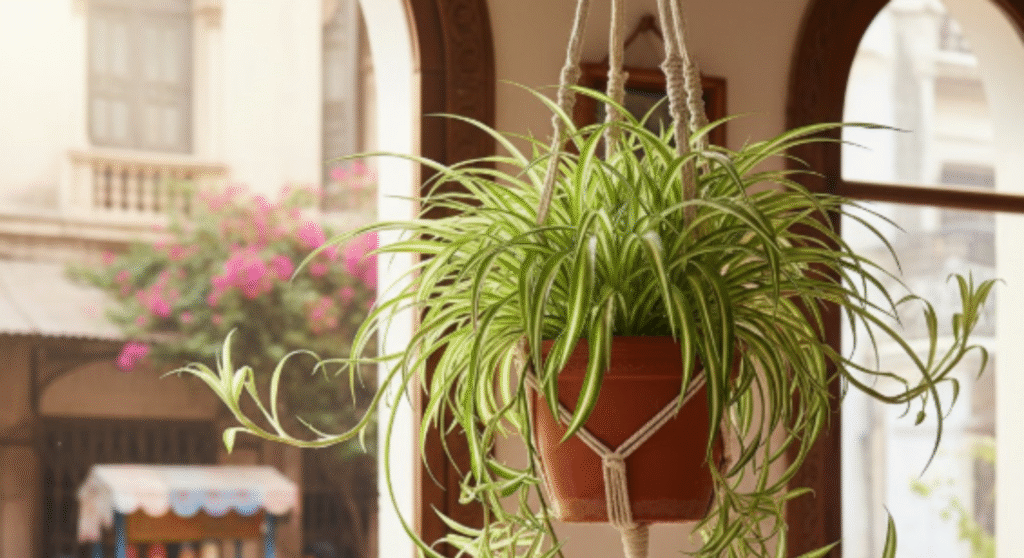
I still remember my neighbour, Mrs. Rao, in our old Hyderabad colony. Her balcony was a jungle, and right at the centre of it, dangling gracefully from a macrame hanger, was a magnificent specimen of the Spider Plant (Chlorophytum comosum). For her, this lovely plant was not just decor; it was a testament to simplicity, thriving even when she was away for a week visiting her folks in Andhra Pradesh. The truth is, if there’s one indoor plant that truly epitomises ‘set it and forget it’ in the Indian context, it’s this hardy, air-purifying champion.
In a country where most of us are constantly juggling the heat, a few days of power cuts, and an attention span often diverted by everything from traffic chaos to the latest cricket score, we need houseplants that don’t demand the kind of attention a newborn baby does. The Ultimate Guide to Growing Spider Plant at Home starts not with complex instructions, but with a simple understanding: this is a plant that wants to survive, flourish, and multiply, almost by sheer force of will. Think of it as the sturdy, reliable Bharati plant—tough, resilient, and beautiful without being fussy.
Finding the Sweet Spot: Light and Location for Your Green Friend
Ask any seasoned gardener, and they’ll tell you that the right Aasan (seat or position) is half the battle won for any indoor plant. For the Chlorophytum genus, that spot is one of bright, indirect light.
Forget the punishing afternoon sun that beats down on a typical Chennai or Mumbai balcony—that’s a guaranteed ticket to brown, scorched leaf tips, which look worse than a freshly painted wall after the monsoon. Our ribbon-leafed friend thrives best when it’s near a window that gets good morning light or is simply brightly lit throughout the day, like a north or east-facing window. Picture a government clerk’s desk in the corner of a busy RTO office: visible, but not directly under the blinding, intense spotlight. That’s the kind of shade your green-and-white variegated foliage plant craves.
Placing your specimen just a few feet away from a well-lit window, or perhaps tucked under the soft glow of a tube light in a living room, is usually perfect. The beauty of this tough plant is its forgiving nature; while it will not produce as many characteristic ‘spiderettes’ or babies in low light, it won’t throw a tantrum and die on you either.
The Balancing Act: Watering and Soil for the Fleshy-Rooted Plant
When it comes to watering, many new plant parents, bless their enthusiastic hearts, tend to overdo it. They treat their pots like a municipal water tank—always full, always overflowing. But the Spider Plant is an African native and stores water in its thick, fleshy roots—a clever, inbuilt survival mechanism. Overwatering is the single most common cause of root rot, a silent killer in the potted plant world.
The mantra here is simple: let the soil dry out, like your wallet after Diwali shopping, before you water again. Stick your finger an inch or two into the soil; if it feels dry, it’s time for a good soak. If it’s still damp, wait a day or two. In the peak summer heat of a place like Pune or Bengaluru, you might water every 4-5 days. During the cooler, slower winter months, you could easily stretch that to 10-14 days.
For the soil itself, a well-draining, slightly loamy mix is ideal. We’re talking about a blend that allows water to pass through freely, much like a good filter coffee. A standard potting mix, perhaps with a little bit of sand or coco peat mixed in for that extra drainage, works like magic. Good drainage is non-negotiable, so ensure your pot has a hole at the bottom. Without proper drainage, even the toughest ribbon plant will struggle.
When to Think About Upgrading: Repotting Your Thriving Houseplant
One of the signs of a truly happy and healthy airplane plant is that it grows, and grows fast. Soon enough, you’ll notice the robust, pale roots starting to peek out of the drainage holes. This is the plant sending you a polite but firm signal: “It’s time to move to a bigger home, ji!”
Repotting is not rocket science; it’s a simple spring-cleaning exercise. Choose a pot that is only one size larger than the current one—about an inch or two wider in diameter. This houseplant actually prefers to be slightly root-bound, a bit snug, like a comfortable, well-worn sweater. Over-potting (putting a small plant into a giant pot) can leave too much empty soil, which retains excess moisture and, you guessed it, encourages root rot.
The best time to repot is just before the growing season starts, typically in spring, when the plant is raring to go. Gently remove it, inspect the root ball (it will look dense and white), and settle it into its new, slightly larger container with fresh potting mix. It’s like moving from a modest apartment to a spacious 2BHK with enough room to stretch, but not so much that it feels lost.
The Joy of Multiplication: Propagating the Baby Plantlets
This is where the Chlorophytum comosum truly earns its friendly reputation. The plant produces long, wiry stems that eventually sprout small, miniature versions of the parent plant, known as ‘spiderettes’ or plantlets. They dangle charmingly, giving the plant its common, arachnid-inspired name. These are essentially free, ready-made plants!
Propagating them is as easy as grabbing a roadside chai on a chilly evening. You have two main options:
- The Water Method: Simply snip off a plantlet (make sure it has tiny aerial roots already) and place the base in a small glass of water. Within a couple of weeks, you’ll see substantial roots develop. Once rooted well, transfer it to the soil.
- The Soil Method (The Safer Bet): Take a plantlet and set it directly onto the soil of a new small pot, while it is still attached to the mother plant. This allows the baby to draw nutrients and moisture from both sources while it establishes its own roots. Once rooted (it will offer some resistance when you gently tug it), snip the connecting stem.
It’s an incredibly rewarding experience, watching these little spiderettes root and grow. You can gift them to friends, use them to fill other empty corners of your home, or even sell them at your local weekend market a true cottage industry plant, if ever there was one.
The Hidden Benefits: Not Just a Pretty Houseplant
Beyond its low-maintenance care, this ribbon plant offers tangible, useful benefits, which is why it has endured as an indoor staple for generations.
The most famous benefit is its air-purifying capability. Back in the day, NASA’s Clean Air Study highlighted the spider plant’s remarkable ability to filter out common household toxins like formaldehyde and xylene from the air. In our polluted metropolitan environments, from Delhi’s hazy winters to the dust of a construction site in Ahmedabad, having a few of these in your home acts like a small, natural air filter, tirelessly working to clean the air you breathe. It’s like having a dedicated safai karamchari (cleanliness worker) on your side, 24/7.
Furthermore, studies have shown that having houseplants like this green friend around can reduce stress, enhance focus, and even help speed up recovery in hospital patients. It adds a peaceful, natural element to the home, creating a subtle sukoon (peace) that is priceless in today’s high-stress life.
The Fine-Tuning: Keeping Your Foliage Vibrantly Variegated
While the Chlorophytum is resilient, there are a few small things to watch out for to ensure those lovely, striped leaves stay vibrant.
The dreaded brown tips: This is a common phenomenon that makes people panic, but it’s usually not a big deal. It’s often caused by salt and chemical build-up from tap water (fluoride and chlorine). An easy fix? If you have access to rainwater, use it. Otherwise, leave your tap water out in an open container overnight, which allows some of the chlorine to dissipate. You can simply snip the brown tips off with clean scissors—it won’t hurt the plant.
Pest Control: Fortunately, this variegated foliage plant is mostly pest-free. However, on occasion, you might spot mealybugs or scales. A quick wipe-down with a cotton swab dipped in neem oil solution is usually enough to send these tiny intruders packing. Remember, prevention is better than cure, so a routine check of your plants is highly recommended.
Building a Local Green Business with the Spider Plant
Mastering the art of growing this resilient houseplant is more than just a hobby; it’s a pathway to better living and, for entrepreneurs, a scalable business opportunity. The demand for low-maintenance, air-purifying indoor plants is booming, driven by a growing awareness of wellness and the need for greenery in cramped city spaces.
For any local business looking to tap into this green wave, understanding the specific needs of the Indian customer—the climate challenges, the budget consciousness, and the desire for hassle-free products—is paramount. The Spider Plant, with its easy propagation and incredible hardiness, is a product that practically sells itself.
When it comes to sourcing and providing quality plants and horticultural solutions that truly resonate with the local market, you need a partner who understands the soil of India, literally and figuratively. That’s where the expertise of Ozrit comes into play. They don’t just sell products; they cultivate growth, providing businesses with the foundational knowledge and high-quality inputs required to grow, package, and market the healthy, thriving Chlorophytum specimens that Indian customers are actively seeking. If your business is ready to branch out into the flourishing world of indoor gardening, connecting with a reliable, local supply chain and knowledge resource, like the one offered by Ozrit, is the smart first step to ensure your green venture doesn’t just survive, but truly thrives in the competitive local environment.
